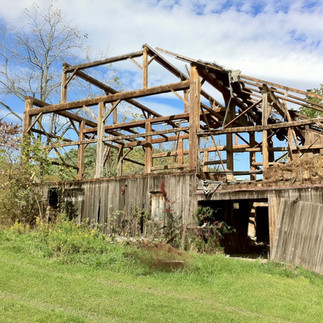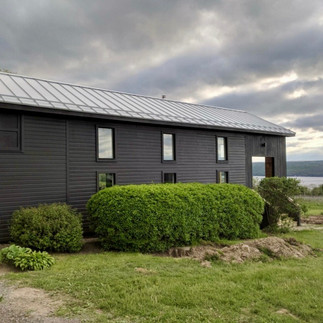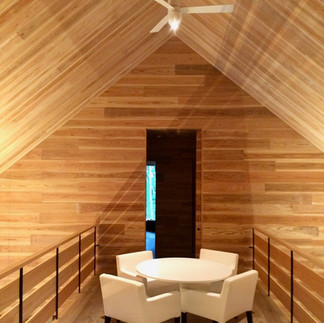Mennonite Modern: 5 Elements that Define the Growing Design Movement in the Finger Lakes
- Jennifer Wolfe
- May 10
- 6 min read
Updated: May 13
DRAFT!

If you've spent time in the Finger Lakes region of New York State, you're likely already familiar with its breathtaking lakescapes, charming small towns, and bucolic 100-year-old hilltop vineyards. The area has long been celebrated for its premier white wines, particularly Rieslings, which thrive in its deep shale and limestone soils. But that's changing. The Finger Lakes' unique terrior now draws award-winning wineries and self-taught vintners alike, scooping up affordable vineyards to start adventurous new blends and perfect single-vineyard gems like the Cab Franc.
It's also home to what I refer to as the 'Mennonite Modern' design movement–modern barns and barn-like structures that pepper the gentle slopes of Canandaigua, Cayuga, Keuka, and Seneca lakes–the heart of the region's wine country. Inspired by the many traditional Mennonite barns that have been here since the '70s, these new modern structures house adventurous new wineries, Michelin-star restaurants, private residences, and lakeside retreats. The award-winning vintner Paul Hobbs lives here. So does celebrated chef & restaurateur, Christopher Bates. Interior designers Thom Filicia (Queer Eye), Tom Johnson (Ralph Lauren), and Lyndsay Caleo Karol (The Brooklyn Co.), have lived and worked in the Finger Lakes for over a decade, incorporating traditional Mennonite style into their architectural, interior, and furniture designs.
Left: a Mennonite farmstead from the 1800s | Middle: community barn-raising | Right: 1970s Mennonite farmhouse
Traditional Mennonite homes were "self-contained farmsteads"—a series of connected buildings that housed a family residence, livestock, farm equipment, and storage. Easily identified by their continuous, connected roofline, they were built for function and durability, and to withstand the region's harsh winters. Their small windows, slatted shutters, large, sliding barn doors, and wide planks remain primary elements in the modern versions.
Top Left: barn doors on a vineyard residence provide unobstructed passage and an abundance of fresh air | Top Middle: a suite designed by The Brooklyn Company | Top Right: The Lake House on Canandaigua is a favorite getaway for New Yorkers | Bottom Left: an old Mennonite barn on Keuka Lake | Bottom Middle: the same barn was meticulously re-assembled into a new lakeside summer residence | Bottom Right: Standing Stone Winery sits on the western slopes of Seneca Lake
Here are some key elements that define the style:
Protected Spaces

Protected spaces are a primary element of both traditional and modern Mennonite interiors. Function is visually integrated into the structure to maintain strong, clean lines and create a sense of enclosure. Natural light is carefully controlled - abundant but not overwhelming - creating pools of warmth rather than stark exposure. Furniture is arranged to facilitate face-to-face interaction, but proportions are generous to invite unhurried use. To echo the signature Mennonite roofline, a singular finish–often planking–is used to continuously connect the interior spaces. Warm wood tones enhance a feeling of protection and warmth, highlighting featured elements through contrast.
This approach is signature to Mennonite Modern aesthetics, where simplicity elevates rather than diminishes.
– SHOP THE LOOK –
Crafted from reclaimed elm wood, the Holland Settee breathes new life into aged timber with intimate, sheltered seating. Simple vertical planes, unadorned surfaces and visible joinery reflect the Mennonite value of honest construction.
With its substantial wooden base, clean edges, and enclosed shade, the Parnell pendant maintains a protected aesthetic, avoiding exposed bulbs.
An Amber Oak finish wraps the ample storage of the Riggs Media Console in natural warmth. This sturdy, solid wood cabinet completely conceals contents to maintain a protected feeling while adding functionality. Clean lines and pocket handles recess for a seamless open.
Multiple Dining Areas

Separate and purposeful dining areas reflected Mennonite values around hospitality, community, and the distinction between everyday living and special occasions. Each space would be furnished appropriately for its function, but all would maintain the characteristic simplicity, durability, and craftsmanship associated with Mennonite furniture. Today, you'll find these distinct dining areas in the Finger Lakes homes of designer Tom Johnson; chef and master sommelier (and James Beard Award semi-finalist) Christopher Bates (F.L.X. Table. Element Winery); and celebrated Sonoma winemaker Paul Hobbs.
– SHOP THE LOOK –
Nova Dining Armchair II in Dawn. Offers a quiet refinement and balances utility with understated refinement. Made from solid oak and upholstered in 100% polyester performance fabric.
Extra-long farmhouse dining table from the early 1900s, made from North American pine with a sturdy H stretcher. 3 plank top left natural with just a coat of wax. Ready to accommodate up to 12 guests.
Nova Dining Side chair in Dusk. Made from solid oak with handcrafted parquetry design. Effortlessly pairs with other Nova dining chairs for a casual, mixed look while keeping tonal balance.

The straightforward construction of the Gardendale Island from Four Hands emphasizes craftsmanship over decoration. A simple post-and-panel construction features eight generous drawers, an oak frame, and exposed joint details, all reflect the Mennonite value of 'utility with dignity'.
Planking + Slatting
Robust wooden features, including wide planking, exposed beams, and slatted designs, are hallmarks of both traditional and modern Mennonite design. These elements not only provide structural integrity but also create natural boundaries that define protected spaces within open floor plans. Strategic placement of slatted screens and partial walls offers privacy without sacrificing connection to surrounding areas, while thoughtfully positioned wooden elements shield interiors from harsh environmental factors—filtering intense afternoon sunlight, buffering against strong winds, and creating microclimates of comfort within the home. This practical approach to both protection and privacy reflects the Mennonite value of creating spaces that shelter physically while remaining connected to the natural world.
– SHOP THE LOOK –
Flexible organizer in oak by Woud. Eight movable boxes to steward the most important things or the whimsical finds of the day.
Marco Bogazzi Modern Outdoor Adirondack Chair in solid Teak. Built using mortise and tenon joinery and subtlely curved slats.
The Dallin privacy screen serves as both a boundary and bridge between spaces. It's portable nature allows a continuous framing of views while adapting to changing needs.

Solid teak wood loveseat designed with a slatted back and machine-washable, all-weather UV-resistent cushions.
Functional Minimalism

Similar to Mid-Century philosophy of 'form follows function', Mennonites had a distinctive commitment to simplicity and practicality. Yet, because they embraced new technologies, their furnishings evolved into more active forms. Look for "more than meets the eye" pieces like storage beds,
– SHOP THE LOOK –
Unique English 19th Century Pine Painted Butler's Pantry. Simple raised panel doors open on steel hinges to reveal three sets of upper and lower shelves.
Joan Storage Bed in cream. Beneath the mattress, a hydraulic system reveals ample storage space neatly tucked away, while a fully removable slipcover allows easy cleaning.
Mid 19th c. Primitive Mexican Mennonite Farmhouse Table c.1850 with extra-wide planks, visible nail heads, and concealed drawer.
Intentional Pacing

Creating thoughtful boundaries encourages lingering and a deeper relationship with time. Spaces should resist multi-tasking, reminding us to move through our day with intention rather than urgency–and enjoy the surrounding vineyards. Local wines are proudly displayed in simple cabinetry–and often enjoyed throughout even a day of hard work. Walls are often left bare, in favor of high-end fixtures that provide functional luxury over trending adornment. Objects carry genuine significance. Empty space isn't viewed as an invitation to fill, but as valuable breathing room that allows meaningful pieces to speak. Mennonite tradition values items that emerge naturally from the rhythms of daily life and personal history.
Keep the materials palette intentionally simple and handcrafted: substantial timbers with visible joinery, hand-finished hardwoods, full-grain vegetable-tanned leathers that will develops character over time, and hand-loomed textiles with subtle irregularities that reveal human origin.
– SHOP THE LOOK –
The design of the Halston Chair arrived in the '70s, just like the first Mennonites. Inspired by a flea market find, its dramatically tufted sling seat of top-grain leather angles at a just-right pitch for long, lingering afternoons.
Preserved mounds of moss roll across a natural teak bowl mimicing hills in the distance
The blocky proportions & exposed joints of the Annex Lounge interject with gentle curves, simultaneously echoing Bauhaus and Mennonite styles.




































































Comments